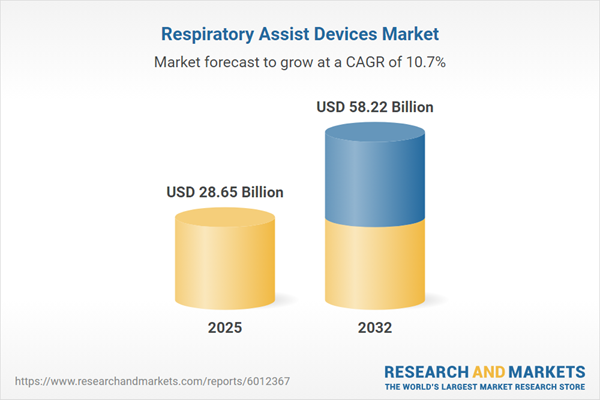Speak directly to the analyst to clarify any post sales queries you may have.
The respiratory assist devices market is evolving rapidly as healthcare organizations seek solutions that prioritize digital connectivity, integration, and sustainability. With growing emphasis on flexible, efficient, and compliant respiratory support technologies, decision-makers are adapting strategies to address new care delivery models and operational demands worldwide.
Market Snapshot: Respiratory Assist Devices Market Size and Growth Outlook
The respiratory assist devices market is projected to increase substantially, reaching a value of USD 25.85 billion in 2024 and USD 28.65 billion in 2025, with a compound annual growth rate (CAGR) of 10.67%. Industry forecasts anticipate this market attaining USD 58.22 billion by 2032, fueled by higher incidence of chronic respiratory diseases and rising adoption of advanced respiratory therapies. The market’s expansion is further propelled by ongoing advancements in both clinical and homecare device technology, paired with accelerating global investment in digital health infrastructure. Leading market participants are adapting to a changing competitive landscape by upgrading their approaches to care integration, regulatory compliance, and technology adoption.
Scope & Segmentation of the Respiratory Assist Devices Market
- Product Types: Includes BiLevel Positive Airway Pressure devices, Continuous Positive Airway Pressure systems, various nebulizers such as jet, mesh, and ultrasonic types, humidifiers, portable and stationary oxygen concentrators, suction pumps, and a range of ventilators, each meeting requirements across care settings.
- Applications: Designed for chronic disease management, sleep therapy, emergency respiratory intervention, perioperative use, and both standard and advanced protocols, enabling adaptable and patient-focused care strategies.
- End Users: Hospitals, ambulatory surgical centers, specialty clinics, as well as homecare providers demand seamless integration with existing workflows, regulatory compliance, and consistent quality in their delivery of respiratory services.
- Distribution Channels: Direct manufacturer sales, distribution partners, e-commerce platforms, and retail pharmacy networks play vital roles in expanding market access, technical service capability, and scalable global distribution.
- Geographic Regions: The Americas, Europe, Middle East, Africa, and Asia-Pacific each contribute distinct challenges related to regulatory requirements, market maturity, and logistics, shaping adoption and movement of respiratory assist solutions.
- Key Companies: Prominent organizations such as Koninklijke Philips N.V., ResMed Inc., GE Healthcare, Medtronic PLC, Drägerwerk AG & Co. KGaA, Baxter International Inc., Hamilton Medical AG, Fisher & Paykel Healthcare Corporation Limited, Getinge AB, Genotronics, and AdvaCare Pharma are actively influencing competitive and technological trends within the sector.
Key Takeaways for Senior Decision Makers
- Advanced integration of artificial intelligence and efficient device design is giving providers new capabilities to support evolving patient care standards and operational demands.
- Portable and modular respiratory assist technologies are improving access to support outside of traditional hospital environments, facilitating decentralized care models.
- Emerging regulatory trends are streamlining device approvals and facilitating quicker compliance with international safety and quality protocols.
- Sustainability and reusability in device design are becoming critical for organizations aiming to achieve operational efficiency and meet environmental goals.
- Organizations optimizing supply chain management and embracing modular product strategies gain resilience in the face of supply disruptions and regulatory changes.
- Collaboration across established companies and new entrants is accelerating interoperability, supporting faster technology integration within healthcare systems.
Tariff Impact: Navigating U.S. Policy Changes and Supply Chain Realignment
Recent updates to the U.S. tariff policy have made it necessary for respiratory assist device manufacturers to realign supply chains. Organizations are prioritizing nearshoring and building local partnerships with suppliers, which strengthens their ability to manage inventory risks and respond quickly to regulatory or pricing changes. Focusing on modular device formats and regional sourcing enhances agility for manufacturers operating in North America and linked international markets.
Methodology & Data Sources
This report is based on direct interviews with clinical professionals, regulatory authorities, and technical experts. Findings are validated with a robust blend of qualitative and quantitative tools, including SWOT analysis, Porter’s Five Forces, compliance assessments, and on-site reviews to ensure a well-rounded and accurate market overview.
Respiratory Assist Devices Market: Why This Report Matters
- Detailed segment and region-specific insights support strategic leadership decisions on market entry and allocation of resources.
- The report’s findings empower organizations to navigate dynamic competition, evolving regulations, and partnership opportunities across the medical device landscape.
- Practical guidance helps leaders build supply chain resilience and safeguard operational performance amid increasing market complexity.
Conclusion
Organizations that focus on digital transformation, adaptability to regional nuances, and sustainable operations are best positioned to maintain resilience and relevance as the respiratory assist devices market continues to transform.
Additional Product Information:
- Purchase of this report includes 1 year online access with quarterly updates.
- This report can be updated on request. Please contact our Customer Experience team using the Ask a Question widget on our website.
Table of Contents
3. Executive Summary
4. Market Overview
7. Cumulative Impact of Artificial Intelligence 2025
Companies Mentioned
The companies profiled in this Respiratory Assist Devices market report include:- Koninklijke Philips N.V.
- ResMed Inc.
- GE Healthcare
- Medtronic PLC
- Drägerwerk AG & Co. KGaA
- Baxter International Inc.
- Hamilton Medical AG
- Fisher & Paykel Healthcare Corporation Limited
- Getinge AB
- Genotronics
- AdvaCare Pharma
Table Information
| Report Attribute | Details |
|---|---|
| No. of Pages | 186 |
| Published | October 2025 |
| Forecast Period | 2025 - 2032 |
| Estimated Market Value ( USD | $ 28.65 Billion |
| Forecasted Market Value ( USD | $ 58.22 Billion |
| Compound Annual Growth Rate | 10.6% |
| Regions Covered | Global |
| No. of Companies Mentioned | 12 |









